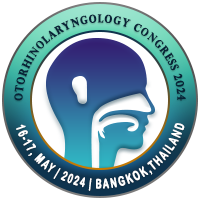
Aikaterini Drylli
Harokopio University, Athens, GreeceTitle: Epidemiological profile of allergic rhinitis in child and adolescent Greek population: Review of the literature & How common is Rhinitis Medicamentosa in an ENT outpatient clinic?
Abstract
Abstract3
Allergic rhinitis is a common chronic disorder and affects over 400 million people worldwide. The typical symptoms of the disease include rhinorrhea, nasal obstruction, nasal itching, and repetitive sneezing. The aim of this study was the investigation of the epidemiological characteristics of children and adolescents with allergic rhinitis in the Greek population. A systematic review was performed including the published scientific literature, in the English language, in electronic databases (PubMed, ScienceDirect, Cochrane Library) using the appropriate MeSH terms [allergic rhinitis; Greece; Greek; child; adolescent] for related studies about the profile of children and adolescents with allergic rhinitis in the Greek population for the period 1990-2022. We found 12 studies, prospective and cross-sectional, in Athens, Thessaloniki, Patras and Evros prefecture, involving among 517 and 3076 subjects aged 6-17 years old. Factors such as gender, age, environmental exposures as well as personal and family atopic history were related to the presentation of the disease. The majority of the children and adolescents with allergic rhinitis in the Greek population were boys, between 8 to 10 years old, with personal or family past medical history of asthma and eczema, who have been positive in prick test for moisture, mites and fungi. It is an unquestionable fact that further methodical research in the Greek child and adolescent population with allergic rhinitis is vital in order to estimate and control disease manifestation’s, not only at the individual but also at the public level.
Abstract 4
Rhinitis medicamentosa (RM), also known as rebound or chemical rhinitis, is a form of non-allergic irritation and inflammation of the mucous membrane inside the nose. Its incidence is approximately 1-9% worldwide and rarely occurs in children or adolescents. It is characterized by constant nasal obstruction without rhinorrhea, postnasal drip, or sneezing. It is usually induced by the prolonged use of intranasal decongestants for more than 5?days straight. However, sometimes RM is related to regular or occasional using drugs such as antihypertensives, phosphodiesterase type 5 inhibitors, antipsychotics, oral contraceptives, and antiinflamatories. In the ENT outpatient clinic, 56 patients presented by persistent nasal obstruction from 01/05/2022 to 31/10/2022. Five women and two men were diagnosed with RM (12.5%). Five patients were adults aged from 31 to 68 years old. In contrast, 28.6% were up to 15 years old. The vast majority (71.4%) had a pale and edematous nasal mucosa as well as a positive history of continued use of topical decongestants for a period between two weeks to three years. Subjects who used intranasal sympathomimetic amines (20%) had chronic sinusitis and nasal polyposis while patients with allergic or viral rhinitis applied imidazolines (80%). Furthermore, in two patients the nasal examination revealed an atrophic and crusted mucosa following oral systematic use of contraceptives by a young woman and beta-blockers antihypertensives by a middle-aged man. All patients received intranasal treatment by saline rinses and steroids as well as the cessation of medication that cause RM. As a common and preventable condition, it is vital not only for the early diagnosis of RM but also for the interruption of the medication that caused the nasal blockage.
Biography
Aikaterini Drylli is aan ENT consultant in the Medical Center of Moschato, Athens, Greece. She has completed three masters’ courses such as Metabolic Diseases of Bones, Audiology-Neurotology, and Biostatistics. She has been a researcher for more than 4 years at projects of National and Kapodistrian University of Athens, Greece. She has participated in 76 medical conferences, both national and international, with 96 oral and poster presentations. She has 20 publications that have been cited 12 times.

